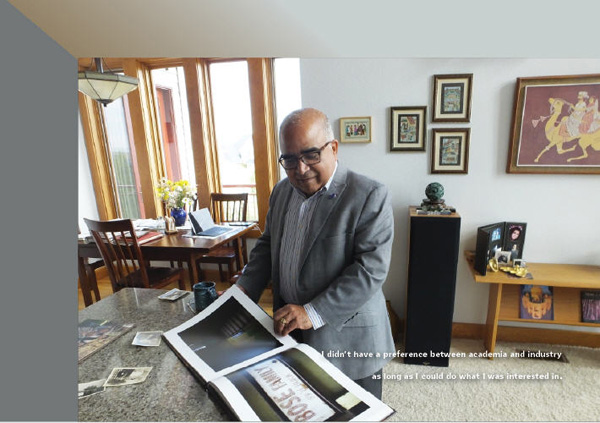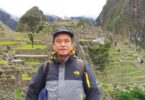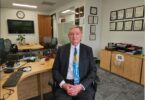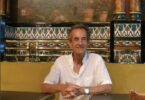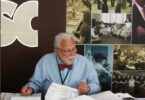PAC World: When and where were you born?
A.B.: June 2, 1946, Kolkata (then Calcutta), India.
PAC World: Where did you grow up and where did you go to school?
A.B.: We moved to Burnpur in West Bengal about 150 miles from Kolkata, a small town with a very large steel factory where everyone in the town worked. I attended St. Patrick’s School run by the Irish Christian Brothers who catered to the large industrial population in the area.
PAC World: What were your interests while in school?
A.B.: My main pastime was reading whatever I could lay my hands on in three languages. I was not into sports but was captain of the debate and sp eech teams.
eech teams.
PAC World: Who is the person in your childhood that had the most influence on you?
A.B.: My father, Amal Nath Bose, who after finishing 10th grade had gone on to an apprenticeship in a steel factory at the age of 16. But he had an intense curiosity of how the world works in general and man-made things in particular. He never had a chance to go to college but worked his way up to engineering and management positions. He instilled in his two sons the same curiosity and both of us became engineers.
PAC World: Why did you decide to be an engineer?
A.B.: In an industrial area where most little boys expected to work in factories the aspiration for all was to become an engineer so you started out as a management trainee rather than as a laborer. In fact, engineering was the only profession I was familiar with. Moreover, the newly independent India wanted to rapidly industrialize from a colonial economy to a modern one and government policy was to encourage more young people into engineering.
PAC World: Where did you go to university and how did you choose it?
A.B: Indian Institute of Technology – Kharagpur (in W. Bengal). This was the first of the five IIT campuses planned by the government to be the top engineering institutes in the country with admission by examination. I was lucky to have been admitted.
PAC World: Why did you decide to study electrical engineering?
A.B.: Growing up in a steel factory town, I always thought I’d be a metallurgical engineer but I changed my mind just before I submitted my college applications. It was a chance conversation with my father and his colleagues at the factory who said that non-engineers could learn the mechanical and metallurgical workings of a factory but the electrical equipment remained mysterious. Of course, that intrigued me to no end.
PAC World: Why did you decide to continue your education in the United States?
A.B.: I was an indifferent student as I just assumed that I was going to go work as an engineer in a factory after I graduated (in 1967 most engineering jobs in India were in factories) and all these equations I was learning were not going to be of much use. But in the senior year a few of my friends were applying to graduate schools in the USA and when I casually mentioned this to my father he wanted to know why I wasn’t doing the same. When I brought up the usual excuses about not having the grades or the funds, he pointed out that I couldn’t be sure unless I tried.
PAC World: What was the reason to go to University of California, Berkeley?
A.B.: UC Berkeley was the top public university in the US and had the best ranked electrical engineering department, so the question is not why I chose Berkeley but why they chose me. I had C and D grades on my record and I was even surprised when they put me on a waiting list. When in the summer of 1967 I was preparing to join the University of Utah, Berkeley wanted to see my final year grades which were all As, which seemed to have done the trick.

PAC World: Did you find significant differences in the education between India and the US?
A.B.: The curriculum was more or less the same but the teaching style in the US was less formal, there was a lot less spoon-feeding, contact hours were shorter and students were expected to pick up a lot more on their own. This I found quite refreshing but what affected me was that the engineering curriculum was already changing in the US whereas India was catching up. For example, I was the last graduating class at IIT that were not taught computers or computer programming whereas I was expected to know how to program at Berkeley.
PAC World: What made you interested in electric power systems?
A.B.: I was generally taking classes in control systems which Berkeley was particularly known for in those days but the research project I was assigned was on the then new topic of power flow. It was sponsored by Bonneville Power Administration and Bill Tinney from BPA was the project manager. He had just published the sparse matrix method that made it possible to solve the power flow problem for large power systems. Stepping into that exciting environment was just a stroke of luck and the start of my life-long love of applying computers to power grid problems.
PAC World: You started your career working in a utility. Why did you decide to go back to school?
A.B.: When I got my MS in 1968 the power companies, in the aftermath of the major Northeast blackout of 1965, were rapidly moving to digital computer analysis of the grid. I was one of those first graduates who knew what a power flow was and got hired into the newly formed transmission planning group at Con Edison, the power company for New York City.
This job fascinated me. I was planning the transmission for the Northeastern US and I was using tools that were stretching my knowledge. For the first time I was not only using everything I had learned, I felt I didn’t know enough to do all the analysis that I needed. The power flow software was quite established during the two years 1968-70 that I worked there but the transient stability software was still in its infancy. I realized that much of the fundamental knowledge to develop the computer methods for transient stability of large power systems were still in research stages. Before I found the university where I wanted to do my PhD, I knew what I wanted to do it in. I found Paul Anderson and Aziz Fouad at Iowa State University who were leading this research in 1970 and would later write the first book on the computer analysis of transient stability.
PAC World: What made you stay in the US after you graduated?
A.B.: By the time I got my PhD I was hooked on the application of computers to the power grid. India at this time had become a socialist and nationalized economy with no opportunities to do this kind of work. So I decided to find work in the USA.
PAC World: After getting your Ph.D. you switched between academia and industry. Were you trying to figure out which one to choose?
A.B.: I didn’t have a preference between academia and industry as long as I could do what I was interested in. I spent a year developing transient stability programs at IBM and then a year teaching at Clarkson University before I lucked into my dream job.
Control Data Corporation (CDC) built the highest performing computers in those days and having entered the control center business by acquiring a small SCADA company, wanted to utilize their big computers for on-line analysis. They decided to build the first commercially available Energy Management System (EMS) and I was hired to lead a group that developed the advanced applications (state estimator, contingency analysis, optimal power flow) software. This brought about a major transformation in the control center industry and all the vendors were selling EMS by 1980 but not before CDC grabbed a dominant market share. (When CDC went out of business this EMS division was acquired by Siemens.)
My PhD advisor, Paul Anderson, had moved to Arizona State University where he was building up the power engineering group and kept twisting my arm to join him. I did that in 1982 thinking that an academic position would give me more freedom to choose my own research direction. I have stayed in academia ever since with one shift to Washington State University but my work in industry building, installing, testing on-line software gave me the confidence to choose research directions that continued to have impact on the real world.
PAC World: What do you think about the importance of cooperation between universities and industry?
A.B.: For engineering education this is crucial. Faculty needs the cooperation to be able to teach concepts with real world applications and conduct research on problems facing industry; and industry needs well-trained professionals and research that is relevant. Unfortunately, the level of cooperation is pathetically low in general and the percentage of faculty with significant exposure to industry continues to decrease.
PAC World: You have been working in academia for almost forty years. What is the difference in the students today and 50 years ago?
A.B.: I don’t think there is a lot of difference between the students of today and yesterday but there is much less interest in an engineering career, especially among the young generation in the more developed countries. The only reason this has not hurt the ability of the developed countries to still lead in innovation is the immigration from the less developed. However, this is not a sustainable situation as countries catch up in living standards.
PAC World: Based on your experience, what do we need to do to attract more young people to the field of electric power systems?
A.B.: This is really country specific. In China, the power industry attracts the best and the brightest as it pushes innovation and new application. The same industry is considered by young people in developed countries to be static and even backward looking doing new things only if required by government regulators. Although these are general truths, in a large industry like this there are ample opportunities to contribute and among my students and colleagues are many who have had very successful and rewarding careers. The only way to attract more young people is to hold up these opportunities and change the pathetic image of power engineering in countries like the USA. I see some real possibilities in the growing interest of the young in the area of energy and smart grid.
PAC World: You have been actively involved in both IEEE and CIGRE. How do you see their role?
A.B.: I joined the IEEE when I was a student and got involved with technical activities after I started working. One aspect of this technical work I enjoyed the most is being on committees with others in the same field comparing best practices. I realized that CIGRE did even more of this with their technical reports being largely surveys of best practices all over the world. There is a difference in professional perspective – IEEE much more interested in theory and methods and CIGRE more in practice and experience. I find it very refreshing to be involved in both.
PAC World: You have been a consultant to many utilities, manufacturers and organizations. What are the benefits of academics working with industry?
A.B.: Every academic chooses to work in a different part of the knowledge spectrum. Having spent many years in industry mostly in analytical tool development, when I became a faculty member I found it unsatisfactory to be working on methods and tools that couldn’t be tested on real applications. I find it more satisfying to know that hundreds of operators are being trained on the training simulator I developed than that other researchers have cited my methods in other papers.
PAC World: What do you think is the impact of IEC 61850 on the future of power systems control and security?
A.B.: So far, the adoption of 61850 in practice, especially in North America, has been disappointing. I believe that the utility industry should be much more pro-active in developing, adopting and installing standards like 61850. Such standards open up competitive space eliminating ‘vendor-lock’ allowing power companies to choose and pick vendors much more smoothly.
Instead, during my 50-year career this industry has gone backwards about adopting standards and appear to only do so if mandated by regulators.
PAC World: What do you consider your greatest professional achievement?
A.B.: Looking back, I feel that my contributions to the application of computers to control centers that gave birth to the Energy Management Systems in the 70s that have persisted in a similar form to this day. I have had a chance to work on all aspects of these modern control centers from the architecture of the modern EMS, the various applications like State Estimator, Security Analysis, Optimal Power Flow, to the Operator Training Simulators.
PAC World: You have received many awards. Which one do you consider the most important to you?
A.B.: The one that touched me the most was the Distinguished Alumni Award from the Indian Institute of Technology (IIT), Kharagpur where I received my first engineering degree. I came from a small working class factory town and throughout college felt inadequate competing with the best students in the country from successful families in big cities. The alumni from IIT spread all over the world and have been brilliantly successful as entrepreneurs, corporate executives and researchers.
When I was picked as one of the five alumni for special mention at the 50th graduation ceremonies at IIT, it was the least expected and most sentimental of honors.
PAC World: Do you believe that we are going to see real time dynamic state estimation based power system stability risk assessment?
A.B.: Dynamic state estimation and system stability risk mean different things to different people. From some viewpoints this is already possible and it can be said with certainty that the tools in this area are getting better. The faster and more accurate synchrophasor measurements make it possible to better track power system dynamics and analytical tools to analyze the impact of disturbances are also available. How these tools can be utilized by the operator or automatic control or protection schemes is still evolving.
PAC World: You are not only involved in teaching and research, but administrative positions as well. How do you manage all of them together?
A.B.: In a long career, one gets opportunities to do different things. Although doing engineering, and especially engineering research, has always been my first love I have enjoyed teaching, management and policy-making at not just the university but in industry and government as well. I have had to adjust my different responsibilities according to the position I was holding at the time. I had to do less computer programming when my group hit 40 people in industry; I couldn’t teach and had to cut back on research projects when I was the dean of engineering; same when I was immersed in policy work at the Department of Energy.
PAC World: You are still actively involved in IEEE and CIGRE, conferences, consulting and research. You support many government and industry organizations. How do you find the time to do all of that?
A.B.: Like I said, there are only 24 hours a day and one has to adjust what one can do according to what is the most important at that time. Also, with experience one can handle many more responsibilities as long as there are people you can delegate to. Of course, I do like being involved in various things especially if they are something I am passionate about.
PAC World: How do you balance your active professional life with your family life?
A.B.: Unlike many people, I have never been able to separate my professional and personal lives. So my family has always been used to me doing work after bedtime stories, or sightseeing Paris between presenting papers at conferences. I am not sure if I compensated enough by taking time off from work to do things like little league games.
PAC World: What do you consider your greatest personal achievement?
A.B.: Not having too many hobbies, it is hard to think of great personal achievements. I feel extremely lucky to have had a very normal family life raising three children who now lead happy fulfilling lives.
PAC World: What do you like to do when you are not working?
A.B.: For relaxation I read, a habit from childhood. Although I am interested in a wide range of subjects, I have increasingly become more interested in history and the ebb and flow of civilizations (which has a close correlation with human knowledge).
PAC World: You travel a lot all over the world. Do you have a favorite place?
A.B: Not particularly. I like cultures, foods, natural beauty, local history, etc. so going to new places excites me. I am saddened by the fact that some interesting places in the world are racked with war and difficult politics, while more remain in abject poverty, making traveling difficult.
PAC World: You have been married for more than 40 years. What is the secret?
A.B: An understanding wife and lots of luck.
PAC World: Do you have favorite music?
A.B: Classical, both Indian and Western. I didn’t grow up with a lot of music around me and cannot sing or play an instrument but I have learned to appreciate listening to it.
PAC World: Your favorite form of entertainment?
A.B: Probably reading. I do enjoy the theater, film, music, etc. but not sports.
PAC World: What is your favorite food?
A.B: I appreciate good food and drink from all over the world and having no food restrictions I have enjoyed it all. After all these years I do find myself having a preference for good Indian food that takes me back to my early years.
PAC World: Do you have a motto?
A.B: No. The closest to one that I live by is “Live and Let Live.”
PAC World: Is there anything you would like to say to the young PAC engineers around the world?
A.B: Protection, automation and control of the power system is going through a major transformation and because we are in the middle of it, it is difficult to predict exactly where the technology is going. So the opportunity to get involved and contribute to the new technologies and take it in new directions is now.
The boundaries between protection and control has already blurred and although automation is still some ways away from making the human operator obsolete, the operator continues to get new assistance tools that can make system operation easier.
PAC World: Is there anything that we didn’t ask you that you think can help our readers better understand who you are?
A.B: After a 50-year career my first love is still to design new analytical tools for power system operation. But 50 years ago, this industry was technology driven with power companies most often led by executives who were engineers. Today, in the Western countries, utilities are no longer led by engineers and the decisions for the industry are more often made by policy-makers and regulators with legal and financial backgrounds.
I am convinced that unless power engineers get more involved with policy-making and regulation, the West will no longer be leading the transformation in the electricity infrastructure of the future. Many countries like China still consider this infrastructure to be the driver of their economies and are paying much more attention to its technological evolution.




